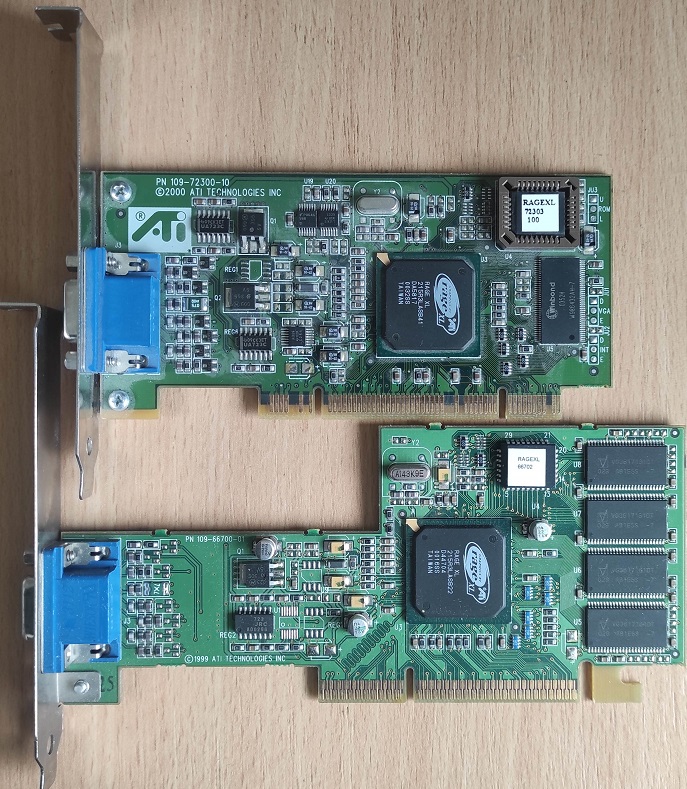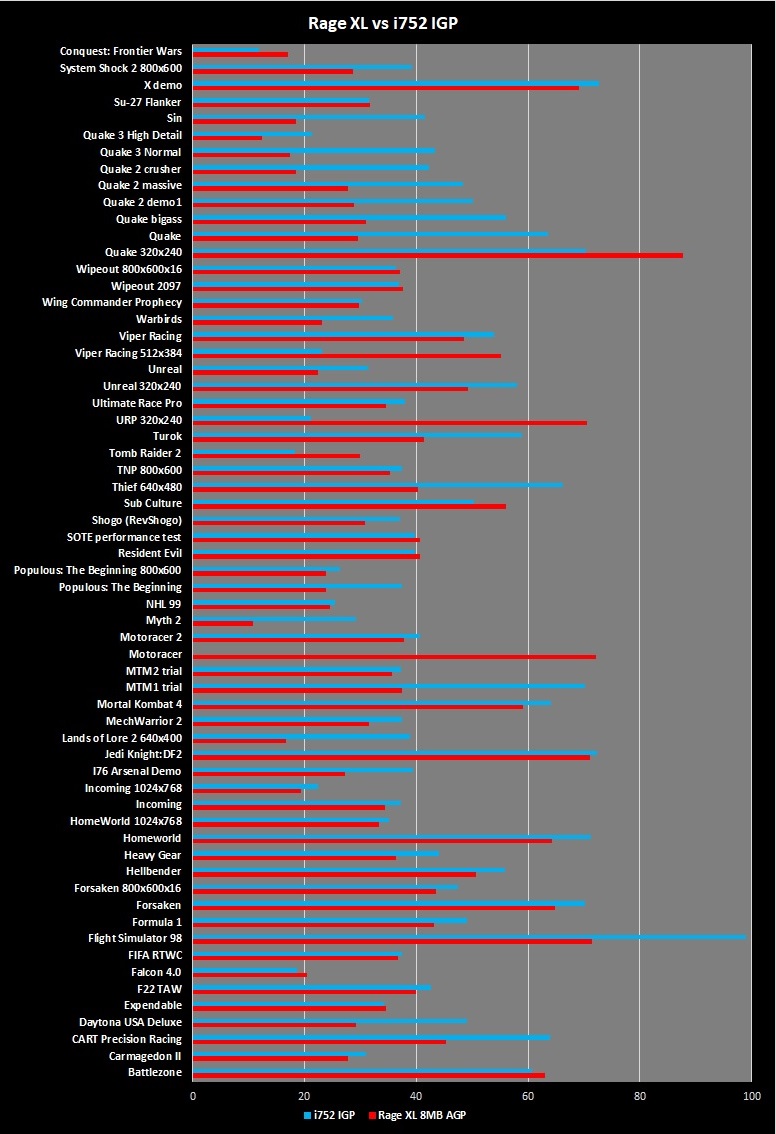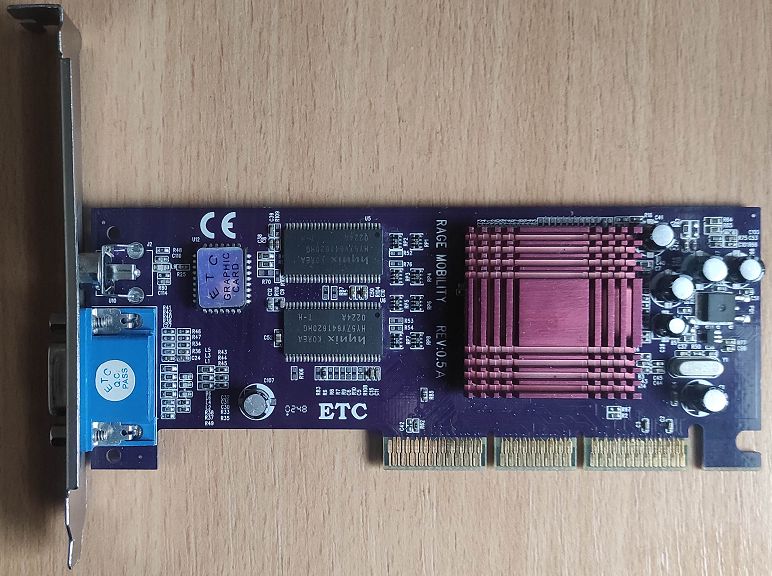Stretching the Rage
When 0.25 um manufacturing became available ATI adopted the R3 core and created mach64GM, used in Rage XL and XC cards. These served as the cheapest discrete offerings during 1999. And as an integrated graphics for servers it went on almost forever. What's more, there are recently built PCI cards, but they are the slower 32-bit memory bus variants and newer bioses break compatibility with old motherboards. Choose carefully. For quite a long time it was thought there were no improvements in the 3d engine and even frequency was hard to determine. Clearly, should the cards have the same clock, Rage XL would be a hair slower than Rage Pro because the cards have only SDRAM without block writes. But new features did not end up with power management and flat panel support. Adding new features brings a risk of breaking old things. And indeed, XLs are only minimally compatible with the proprietary CIF 3D API the first Rage 3D launched with. What are the advantages? Let's dive in.
XL cards aren't extra large
While it was possible to configure older Rage cards to use only half of their 64-bit memory bus, with Rage XL it was the first time ATi made their own specification for 32-bit models. Thus Ati was able to cover quite a wide price range in 1999, from powerful 128-bit Rage 128 down to the simplest Rage XLs.
XL with 32-bit bus typically features a single memory chip. The card tested is the faster variant with a 64-bit memory bus.
The card tested is the faster variant with a 64-bit memory bus.
I am not aware of any software showing proper clocks of the Rage XL. From the datasheet, we know the standard clocks were supposed to be 83 MHz core and 125 MHz memory on the 64-bit cards. The ratio moved from 3:4 to 2:3, giving the XL chips more breathing room in the local memory bandwidth department. 32-bit cards could go even higher to 143 MHz memory clock, compensating a bit of the harsh bandwidth reduction. Fortunately, what ATi drivers do is write memory frequency to the registry. For the card tested it is 120 MHz. Seems like the policy of tolerated clock variances started here along with the Rage 128. Anyway, the card has 20 % faster memory than Rage Pro. The results you will see will fall behind that, making me believe the card uses the 2:3 ratio. Meaning the core runs at 80 MHz, only marginally faster than Rage Pro.
How is the peak of R3 architecture?
 Per-polygon mip-mapping going wrong plus weird lines behind fog.
Per-polygon mip-mapping going wrong plus weird lines behind fog.Rage XL can run mostly happy with the same latest drivers used for the Rage Pro tests. Few times older ones were tried in an attempt to get better results and this revealed quite a distinct image quality disparity. In the texturing engine, the XL has the same reduced magnification precision as the Rage Pro. What was most disturbing to see is mip-map selection. Again, in games like Unreal as the angles vary one can observe how wrong the selection is. Or Viper Racing, suffering all the time from the smallest mip-map on the side fence. Such games look better without mip-mapping, so I disabled it again. This comes with performance hit and noise should a texture be too detailed, but still less disruptive than texture resolution changing all too randomly. Sub-pixel accuracy remained the same as well, there are still some polygon gaps to be seen in a few games. For a detail look head to gallery. One more thing about texture dithering.

Here you see part of a frame in Daytona USA scaled up 4x along each axis. The dithering is annoyingly extensive with the latest driver, introducing the pattern in places where it is not needed. By clicking you can see the same place with another driver. The dither is gone. However, textures show too much color banding. Not all games suffer from this, but having no texture dithering or bad implementation of it can be a tough choice.
Performance
First, shortly about the 32-bit card. I did not run the whole benchmark suit, merely enough to get an estimation of where it lands. And although pure fillrate of the card is badly affected, real games do not suffer to such an extent. The speed is definitely closer to the original Rage Pro than to any Rage II.
When it comes to framerates the 64-bit Rage XL at typical clocks is a slight improvement over the Rage Pro. The card tested reported a memory clock of 120 MHz, possibly 20 % higher than the Rage Pro. Such improvements are rare to see, whence my core clock ratio estimation above.
The much higher gain in minimal framerates demands an explanation: it is mostly due to Falcon 4.0 where the XL no longer came to almost a halt in an intense scene, yielding 7x the speed. Without this one minimal framerate gains would be almost in line with average ones.
But how does the XL compare with something more modern? Lets try the Intel i752 IGP:

In average framerates, the i752 is leading comfortably by 25 %. In minimal framerates, it does even 31 % better. Keep in mind this is the maximal configuration for the IGP, with AIMM module and 133 MHz RAM. Without those the Rage XL could still only achieve parity. This show just how much of a low-end tier this video card from 1999 is: it can tie Intel's integrated graphics from 2000. It would be possible to obtain better XL results by getting the top clocked card and/or removing redundant results from Quake games where the gap is especially wide. But the XL would still not be preferred due to more image quality issues than the i752.
Finishing words
This was the last impression the architecture left on the desktop. On one hand, the XL fulfills the hopes that Rage Pro created. All textures can be filtered and there is a performance boost. This would be great to have in 1997. In terms of 1999, this product is again outdated in terms of both performance and image quality. The redeeming factor was the price. No surprise when heading into modern games the XL would not prove very future-prove. Let's try DirectX 7 era game Conquest: Frontier Wars:
 Despite the ability to texture from system memory nothing helps to render full resolution textures.
Despite the ability to texture from system memory nothing helps to render full resolution textures.
Such a loss of detail has to be contrasted with the fps lead in currently newest game in the suite. For their era, these cards offer basically correct, but no more than basic visuals. The breathing room of Rage XL was defined by willingness of other vendors to create products this cheap.
The whole mach64 line was concluded with mach64LM core of Rage Mobility, a power-efficient chip with added iDCT. Thanks to more obscure vendors we have even mobile cores on desktop cards. These tend to have the lowest clocks.
Thanks to more obscure vendors we have even mobile cores on desktop cards. These tend to have the lowest clocks.
Among companies designing high-performance 3d accelerators, ATI was among the last to deliver dual-texturing pipeline. But when it arrived at the end of the year 1998 in the form of Rage 128, it also demonstrated very advanced design with "full speed" 32-bit depth rendering. The architecture performed well also after 1999 "Pro" update, but ATI still wasn't getting under the skin of gamers. To win in retail earlier availability and good initial drivers were needed. The former being easier to fix, Radeon entered the market in the middle of 2000 as a first direct competition to Nvidia's TnL chips. ATI showed cleverly balanced chips and in a rapidly consolidated market suddenly became the only "real" threat to what was shaping into Nvidia's complete domination. At the end of 2001 Radeon 8500 arrived, and while in the beginning it had some performance problems, it also showed a more advanced shading architecture than Nvidia's. In 2002 finally, all the efforts delivered the big success, Radeon 9700, a card with undisputed performance achievements and solid drivers from the start. And since Nvidia tripped over their shoelaces talent of ATI was no longer to be in doubt. What followed was a series of ATI vs Nvidia battles without a clear conclusion. These cyclical encounters are continuing till today, now of course the ATI brand is hidden under AMD. The takeover of ATI had some critics, but the trend of the future seems to be a convergence of CPU and graphics back into a single device and in this regard, AMD is doing very well. Who knows when, but the day will come when the 3d accelerator as we use it will be unknown to gamers. ATI itself had a strong record of growing through acquisitions, in this order, they absorbed Tseng Labs, Chromatic, Artist, ArtX, XGI, and BitBoys.
ATI Performance summary